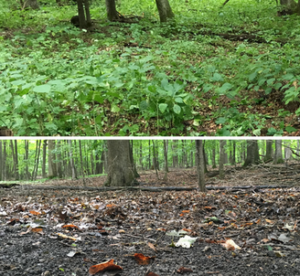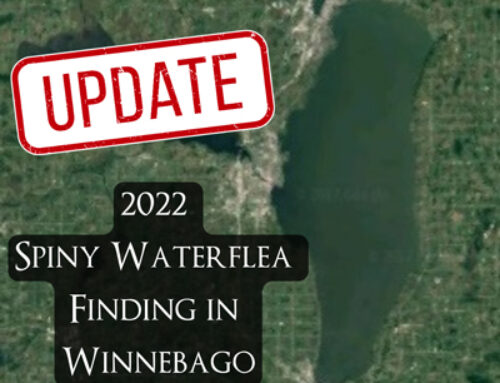Most people think of earthworms as helpful. We know small organisms in nature are important in the nutrient cycle because they break down organic matter into forms plants use. However, even tiny non-native creatures can drastically alter native ecosystems in negative ways. This is the case of earthworms in Wisconsin.
What’s wrong with worms?
One of the most surprising non-native species in Wisconsin is the earthworm (often shortened to “worm”). In fact, the state has not had any native earthworms for thousands of years; since the last retreating glacier scraped the landscape down to bedrock.

Maple forest not yet invaded by earthworms (top), and a similar forest from the region invaded by European earthworms (bottom).
Since then, the forests north of the last glacier evolved without worms. Healthy, unaltered forests are vibrant ecosystems anchored in a complex soil structure full of small organisms that break down organic matter without the help of worms. Wisconsin forests evolved to depend on the slow release of nutrients. A layer of decomposing plant matter – or “leaf litter” – on the forest floor is an essential source of nutrients for plants above ground and provides protection for the soil, organisms, and nutrients below the leaf litter. Worms voraciously consume this leaf litter. A forest heavily infested by earthworms can lose all of its leaf litter in one season. Barren soil then becomes compacted, eroded, and inhospitable for a diverse community of plants. Disturbed soil also makes the forest vulnerable to invasive plant species which can distress or even scatter native animal populations.
How did worms get to Wisconsin?
 The earthworms we find in our gardens, fields, and forests originated from Europe. They were introduced by early settlers in agricultural and horticultural soil. Anglers have furthered the spread of worms sold in bait shops by dumping unused worms at the edge of forested water bodies. Many anglers are not aware that all common bait worms are non-native species, including “night crawlers,” “angle worms,” and “Canadian crawlers.” That’s why we continually urge anglers to throw unused bait in the garbage, never on land or in water.
The earthworms we find in our gardens, fields, and forests originated from Europe. They were introduced by early settlers in agricultural and horticultural soil. Anglers have furthered the spread of worms sold in bait shops by dumping unused worms at the edge of forested water bodies. Many anglers are not aware that all common bait worms are non-native species, including “night crawlers,” “angle worms,” and “Canadian crawlers.” That’s why we continually urge anglers to throw unused bait in the garbage, never on land or in water.






